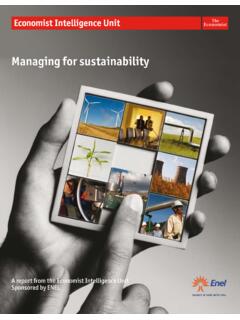Transcription of Measuring Sustainability in - Food and Agriculture ...
1 MeasuringSustainability in Cotton FarmingSystemsTowards a Guidance FrameworkMeasuringSustainability in Cotton FarmingSystemsTowards a Guidance FrameworkReport prepared by the ICAC Expert Panel on Social, Environmental and Economic Performance of Cotton Production with the FAO Plant Production and Protection DivisionFood and Agriculture Organization of the United NationsInternational Cotton Advisory CommitteeRome, 2015 The designations employed and the presentation of material in this information product do notimply the expression of any opinion whatsoever on the part of the Food and AgricultureOrganization of the United Nations (FAO) or the International Cotton Advisory Committee (ICAC)concerning the legal or development status of any country, territory, city or area or of itsauthorities, or concerning the delimitation of its frontiers or boundaries.
2 The mention of specificcompanies or products of manufacturers, whether or not these have been patented, does not implythat these have been endorsed or recommended by FAO or ICAC in preference to others of a similarnature that are not views expressed in this information product are those of the author(s) and do not necessarilyreflect the views or policies of FAO or 978-92-5-108614-8 FAO, 2015 FAO encourages the use, reproduction and dissemination of material in this information where otherwise indicated, material may be copied, downloaded and printed for privatestudy, research and teaching purposes, or for use in non-commercial products or services, providedthat appropriate acknowledgement of FAO as the source and copyright holder is given and thatFAO s endorsement of users views.
3 Products or services is not implied in any requests for translation and adaptation rights, and for resale and other commercial use rightsshould be made via or addressed to information products are available on the FAO website ( ) and can bepurchased through by Studio Ruggieri PoggiTable of ContentsIIIF oreword by FAOIVF oreword by ICACVIP refaceVIIA cknowledgementsVIIIA cronyms and AbbreviationsIXAbout SEEP and this ReportXIExecutive SummaryXII1 Introduction 12 Cotton Production and Cotton Market and Trends63 Sustainability Issues in the Cotton Issues in Sustainable and Pesticide and Land Viability.
4 Poverty Reduction and Food Risk Management Rights and Health and and Organizations574 Identifying Indicators for Measuring Sustainability in Cotton Farming Sustainability Standards Relevant to the Cotton for Rating Sustainability Set of Indicators665 Conclusions and Way Forward736 Bibliography79 Appendix 1 Comprehensive List of Indicators for Measuring Sustainability in Cotton Farming Systems87 Appendix 2 Fact Sheets of Sustainability Initiatives in the Cotton Sector109 Better Cotton Initiative(BCI)110 Cotton made in Africa(CmiA)116 Fairtrade Cotton122 Australian Best Management Practices (myBMP)126 Organic Cotton130 Committee on Sustainability Assessment (COSA)134 Field To Market.
5 The Alliance for Sustainable Agriculture 138 Response-inducing Sustainability Evaluation(RISE)142 Sustainability Assessment of Food and Agriculture Systems (SAFA)146 IVMeasuring Sustainability in Cotton Farming SystemsThe global cotton industry includes more than 100 million farm families across75 countries, and generates about USD billion annually in raw product. Formany of these farmers, however, cotton constitutes only one component of amore complex and integrated farming report presents the outcome of a study designed to Measure Sustainabilityin Cotton Farming Systems.
6 It is the culmination of several years of collaborativeeffort in a robust and science-based assessment of a range of relevant conven-tions, standards and benchmarks. The broad and scientific nature of the consul-tative process that characterized this study has stimulated dialogue acrosssectors and national boundaries and helped to build consensus around criticalsustainability issues and their diversity of farming systems in different geographic areas, the specificity ofsustainability challenges and the synergistic relationship between the differentcomponents of Sustainability preclude the development of a blueprint or one-size-fits-all approach.
7 This report provides stakeholders with the key elements for understanding thepotential threats to the Sustainability of their particular farming system and ex-plains how to perform both measurement and benchmarking. It provides aframework and a common language for farming communities pursuing the dualobjectives of sustainable production and livelihood improvement. FAO s Strategic Framework, particularly its second strategic objective, aims atmaking Agriculture , forestry and fisheries more productive and sustainable.
8 Atits core is a holistic approach to Sustainability , working in a more cross-sectoraland interdisciplinary manner, across the environmental, economic and social as-pects of Sustainability . The development of more integrated policy and en-hanced governance structures are a means for preserving and enhancing thequality of our natural resources without compromising the quantity and qualityof our agricultural by FAOA lthough the study focused on cotton, this report provides a number of indica-tors that can be considered for evaluating Sustainability across a range of agri-cultural production systems.
9 It provides a framework for the continuousimprovement of the Sustainability of agricultural production from practitionersto a result, I believe that it represents a significant contribution towards bridgingthe gap between the universal ambition for Sustainability and the practical real-ities of farming CampanholaDirectorFAO Plant Production and Protection DivisionMeasuring Sustainability in Cotton Farming SystemsVIThe compilation of appropriate Sustainability metrics for the world cotton sectoris the objective of this report prepared by the ICAC Expert Panel on Social.
10 En -vir on men tal and Economic Performance of Cotton Production (SEEP). This doc-ument, which is the product of three years of hard work and selfless dedicationon the part of some of the world s leading experts on cotton, is a giant step for-ward in our understanding of the myriad components that form part of the elu-sive concept of Sustainability when applied to the world of all, the study is important because accurate metrics are fundamental toolsfor evaluating the costs of achieving Sustainability , which are not negligible.



















